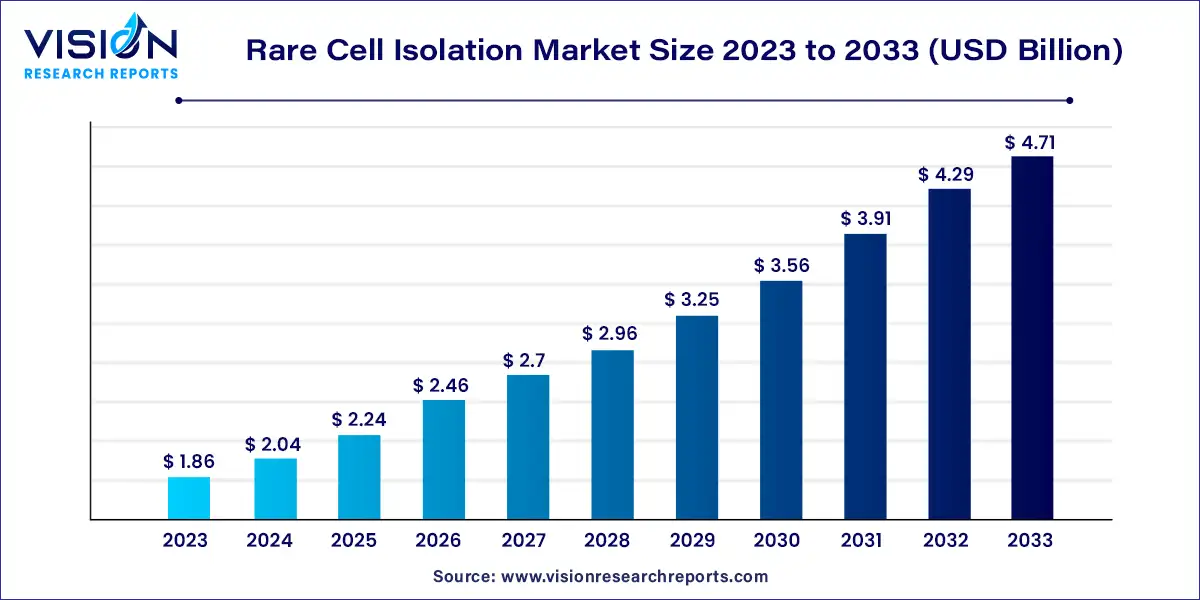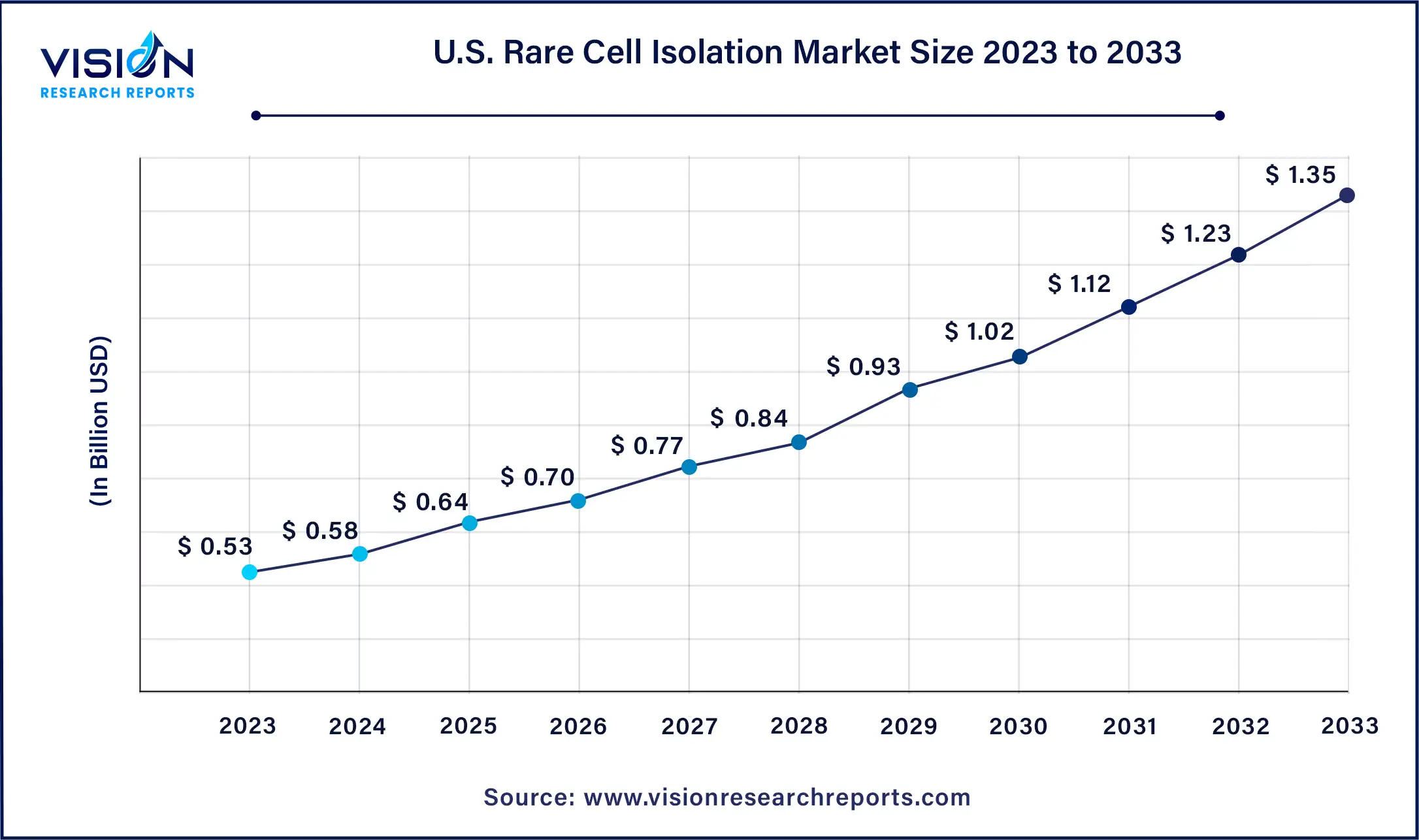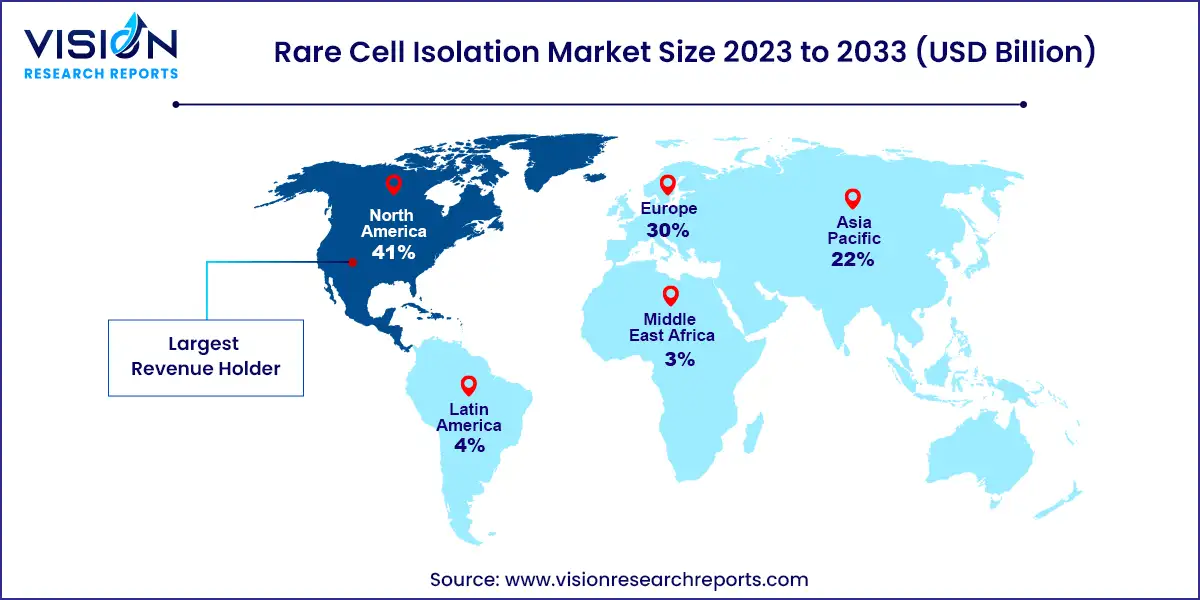The global rare cell isolation market size was estimated at around USD 1.86 billion in 2023 and it is projected to hit around USD 4.71 billion by 2033, growing at a CAGR of 9.73% from 2024 to 2033. Rare cell isolation is a critical technique in biomedical research and clinical diagnostics. It involves separating and identifying rare cells from a heterogeneous cell population, which is essential for various applications, including cancer research, prenatal diagnostics, and stem cell research.

The growth of the rare cell isolation market is driven by an increasing prevalence of cancer and other chronic diseases necessitates advanced diagnostic and therapeutic solutions, propelling the demand for rare cell isolation techniques. Technological advancements in microfluidics, magnetic-activated cell sorting (MACS), and fluorescence-activated cell sorting (FACS) have significantly improved the efficiency, accuracy, and throughput of rare cell isolation processes, making them more accessible and reliable for clinical and research applications. Additionally, the rising focus on personalized medicine, which requires precise characterization of individual cellular profiles, further boosts the market as rare cell isolation is essential for developing targeted therapies and monitoring treatment responses.
The North American rare cell isolation market dominated the global industry with a 41% share in 2023. This dominance is attributed to the region's advanced healthcare infrastructure, the strong presence of leading biotechnology firms, and significant funding for cell research. Additionally, growing healthcare expenditure, increasing awareness of cell therapies, and supportive government initiatives are boosting market growth.
| Attribute | North America |
| Market Value | USD 0.76 Billion |
| Growth Rate | 9.75% CAGR |
| Projected Value | USD 1.93 Billion |
The U.S. rare cell isolation market size was estimated at USD 0.53 billion in 2023 and it is expected to surpass around USD 1.35 billion by 2033, at a CAGR of 9.75% from 2024 to 2033.

In the U.S., the rare cell isolation market is expected to grow over the forecast period due to increasing government funding, a growing focus on cell studies, and the rising prevalence of diseases. Moreover, increasing research in drug discovery, personalized medicine, and targeted therapies is anticipated to fuel market growth.
Europe
The European rare cell isolation market is projected to grow steadily over the forecast period. Europe has been actively involved in cell research, contributing to its growth in the region. Increased investment in R&D focusing on applications such as disease treatment and personalized medicine further propels market growth.
The UK rare cell isolation market is experiencing robust growth, driven by advancements in medical research and an increasing emphasis on personalized medicine. The UK's strong healthcare infrastructure, combined with its world-class research institutions and biotechnology sector, provides a fertile ground for developing and applying cutting-edge cell isolation technologies.

Asia Pacific
The Asia Pacific rare cell isolation market is expected to experience rapid growth, with a projected CAGR of 10.66% from 2024 to 2033. This growth is attributed to the increasing incidence of chronic diseases, growing government support for cell research and development, and a rising preference for rare cell isolation technologies in therapeutics.
China's rare cell isolation market is witnessing rapid growth, underpinned by robust healthcare reforms, a burgeoning biotechnology sector, and significant government investments in biomedical research and innovation. China's focus on advancing precision medicine and developing innovative therapies for cancer and other chronic diseases drives substantial demand for cutting-edge cell isolation technologies.
The Japanese rare cell isolation market is expected to witness rapid growth over the forecast period. Strong government support for medical innovation and research funding, alongside favorable regulatory policies, has catalyzed the development and commercialization of advanced cell isolation technologies, including microfluidics, magnetic bead separation, and automated systems. Leading research institutions and biotechnology companies in Japan are at the forefront of integrating these technologies into clinical and research applications, particularly in oncology and regenerative medicine.
The reagent and kits segment led the market in 2023 and is projected to grow at a higher CAGR of 10.27% during the forecast period. Advanced reagents and kits have significantly enhanced the efficiency and precision of isolating rare cells, such as CTCs and stem cells. These specialized products improve the sensitivity and specificity of isolation methods, making them essential for both research and clinical applications.
The ease of use associated with pre-packaged kits attracts laboratories and clinics, as these kits typically include all necessary components and detailed protocols, reducing the complexity and time required for cell isolation procedures. This convenience is especially appealing in clinical settings, where time and accuracy are crucial. Additionally, continuous innovation and customization by manufacturers cater to a wide range of applications and cell types, ensuring that reagents and kits meet the diverse and evolving needs of researchers and clinicians.
The stem cell segment dominated the market with a 40% share in 2023 and is expected to grow at the highest CAGR of 11.25% from 2024 to 2033. This growth is driven by the unique regenerative capabilities and therapeutic potential of stem cells, which make them a central focus in medical research and clinical applications. The increasing prevalence of chronic diseases and the growing demand for personalized medicine have significantly boosted the need for efficient and reliable stem cell isolation techniques.
Stem cells play a crucial role in understanding disease mechanisms, developing targeted treatments, and conducting preclinical testing. In cancer research, for example, isolating and studying cancer stem cells (CSCs) is vital for developing new therapies and understanding tumor progression and resistance. Advances in stem cell research have led to the development of novel isolation techniques and technologies, such as magnetic-activated cell sorting (MACS), fluorescence-activated cell sorting (FACS), and microfluidics-based platforms, which enhance the efficiency and accuracy of stem cell isolation.
The microfluidics-based techniques segment held the largest market share in 2023. These techniques dominate the market due to their unique advantages and innovative capabilities, which cater to the growing needs of research and clinical applications. Microfluidic devices enable the precise control and manipulation of fluids at the microscale, allowing for the isolation of rare cells, such as CTCs and stem cells, with unprecedented efficiency and accuracy.
One of the primary reasons for the dominance of microfluidics-based techniques is their ability to handle and process very small sample volumes with high throughput. This is particularly advantageous in clinical diagnostics, where patient samples, such as blood, can be limited. Microfluidic platforms can efficiently process these small volumes to isolate rare cells without significant loss, making them ideal for clinical applications.
The magnetic bead separation segment is anticipated to grow at the highest CAGR over the forecast period. Magnetic bead separation is highly adaptable and compatible with various downstream applications. The isolated cells remain viable and functional, allowing for further cultivation, genetic analysis, or therapeutic use. This flexibility makes it a preferred choice for researchers and clinicians who require isolated cells for multiple purposes, from basic research to clinical trials and therapeutic applications. Ongoing advancements in magnetic bead technology and antibody development are enhancing this method's capabilities, with newer generations of magnetic beads being smaller, more uniform, and having improved binding properties, thus increasing the efficiency and yield of cell isolation.
By Products
By Cell Type
By Technology
By Region
 Cross-segment Market Size and Analysis for
Mentioned Segments
Cross-segment Market Size and Analysis for
Mentioned Segments
 Additional Company Profiles (Upto 5 With No Cost)
Additional Company Profiles (Upto 5 With No Cost)
 Additional Countries (Apart From Mentioned Countries)
Additional Countries (Apart From Mentioned Countries)
 Country/Region-specific Report
Country/Region-specific Report
 Go To Market Strategy
Go To Market Strategy
 Region Specific Market Dynamics
Region Specific Market Dynamics Region Level Market Share
Region Level Market Share Import Export Analysis
Import Export Analysis Production Analysis
Production Analysis Others
Others